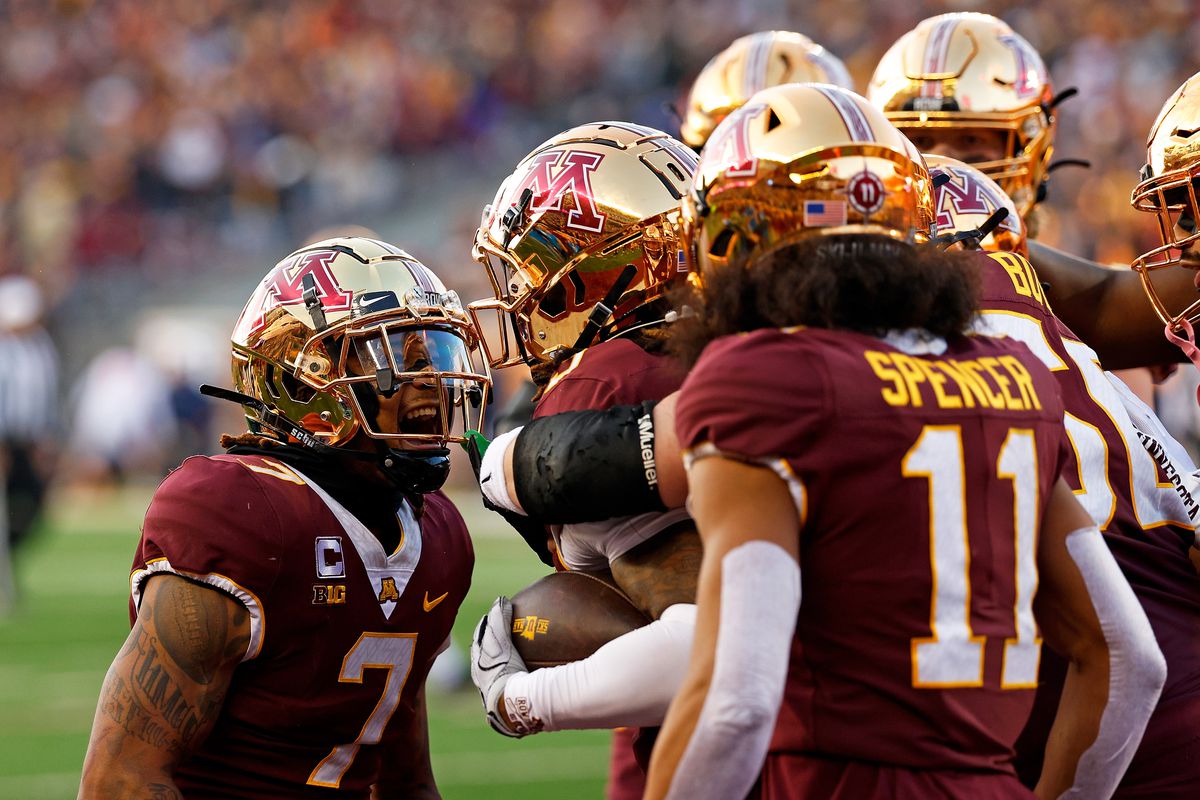
It’s no secret that the passing game for Minnesota Gopher Football has been a challenge throughout most of PJ Fleck’s tenure. The only exception in the past seven years was in 2019, when Tanner Morgan threw for 30 touchdowns, thanks to the presence of NFL receivers Rashod Bateman and Tyler Johnson.
Beyond that, there have been numerous Monday press conferences where Fleck has addressed issues with quarterback accuracy, receiver drops, and missed assignments in pass protection. These issues have collectively contributed to the team’s struggles. Over the last three seasons, Minnesota has not ranked higher than 122nd in pass attempts, leading to a dismal average of 143 passing yards per game last year.
This lack of production is alarming, and their inefficiency and lack of explosiveness have been evident. Athan Kaliakmanis had difficulty putting together complete games, and his receivers were inconsistent, with as many contested catches as drops. Completing only 52.6% of passes, which ranked 123rd out of 133 FBS offenses, is unacceptable. This inconsistency has also contributed to Minnesota’s failure to rank higher than 92nd in 20+ yard receptions in any of the last three years.
One potential solution for Minnesota Gopher Football this fall, with new quarterback Max Brosmer, is implementing a shorter and quicker passing game. This approach was explored during Minnesota’s spring practices and aligns with Brosmer’s strengths demonstrated at New Hampshire over the past two years.
Pro Football Focus data from 2022 and 2023 shows that Brosmer threw within 10 yards of the line of scrimmage 487 times, accounting for over 55% of his passes. This strategy makes sense considering his top skill-position player was tailback Dylan Laube, who was recently drafted by the Las Vegas Raiders. Additionally, Brosmer faced more blitzes than any other quarterback in the FCS last fall. Given the constant pressure and having an NFL-caliber tailback, it was logical for Brosmer to focus on quick, short passes.
Given how productive Max Brosmer was in 2023 on throws within ten yards of the line of scrimmage, it’s understandable why Minnesota focused on this approach during spring practice. The former New Hampshire star completed over 81% of those throws last fall with a 13:2 touchdown-to-interception ratio. He excels at quickly and accurately distributing the ball.
Looking at the structure of the 2024 Minnesota offense, it seems wise to involve tailbacks and tight ends more in the passing game. Analyzing the trends in the Gophers’ passing game under Fleck reveals some surprising patterns. For example, Brosmer targeted his tailbacks 148 times over the past two seasons. In New Hampshire, with an NFL-bound tailback like Dylan Laube, it made sense to frequently target him, leading to Laube’s team-high 88 targets last fall.
In contrast, PJ Fleck’s offenses have targeted tailbacks only 184 times over the last seven years, averaging just 26 times per season, with the highest number being 33 targets in 2017.
To adapt, Gopher offensive coordinator Greg Harbaugh should play to the strengths of his quarterback and pass-catchers. For 2024, Darius Taylor, a former high school receiver, has shown soft hands, and Sieh Bangura caught 50 passes at Ohio. Both can be effective catching out of the backfield.
Beyond All-Big Ten receiver Daniel Jackson, the receiving corps has many uncertainties. Elijah Spencer, despite success at Charlotte, caught only nine passes last fall and has struggled with drops in practice. Lemeke Brockington is recovering from an injury that sidelined him for most of 2023. Additionally, underclassmen like Tyler Williams, Kenric Lanier, and Cristian Driver have minimal game experience.
Therefore, shifting the passing game to focus more on tailbacks and tight ends like Jameson Geers and Pierce Walsh, rather than relying heavily on the less experienced receivers, is a strategy worth serious consideration.
One potential advantage of a shorter passing game is its effectiveness on early downs. Instead of the typical Gopher approach of running inside zone up the middle, mid-zone left, or outside zone right on first down, imagine throwing to Darius Taylor in the flats or hitting Jameson Geers with a short hitch across the middle. Last fall, Minnesota struggled with early down efficiency, and any offensive coordinator will tell you that the playbook opens up significantly when facing 2nd and 3rd-and-short versus 2nd and 3rd-and-long.
For too long, the Gopher offense has been predictable. Diversifying the offense with a quick passing game would give opposing defensive coordinators more to worry about. It benefits the entire offense by opening up the running and play-action games. The more options Greg Harbaugh has at his disposal, the more efficient and explosive Minnesota can become. There will be games where opponents manage to slow down the Gophers’ running game, but leaning on a short passing game to get to 2nd and 3rd-and-manageable situations changes the offensive dynamic.
Ultimately, it will be up to Greg Harbaugh, PJ Fleck, and the Gopher offensive staff to implement this approach. Historically, throwing to running backs has not been a significant part of Minnesota’s offense during the Fleck era.
Having covered this team for over a decade, I’ve seen many spring ball innovations abandoned by fall. However, incorporating a different passing game element in 2024 is crucial. Adapting the scheme to fit the players, rather than forcing the players into a rigid scheme, is essential. Brosmer excels at quick, efficient passing, and the pass-catching talent at tailback and tight end is stronger than ever, while the receivers have struggled.
By committing to a different style of passing, Minnesota can become more efficient and explosive, as these two elements are interrelated. Embrace your strengths, and in 2024, that means adopting a new passing game strategy.
/cdn.vox-cdn.com/uploads/chorus_image/image/72927007/1775211158.0.jpg)






